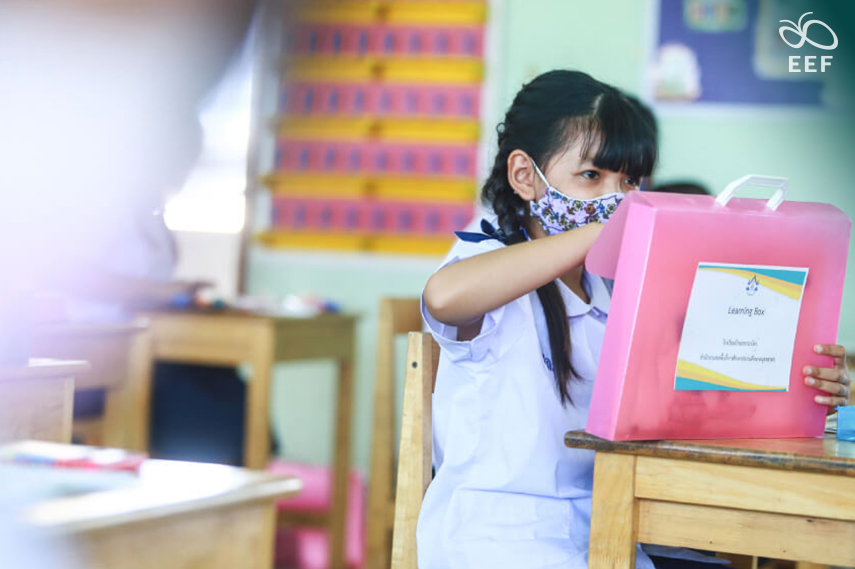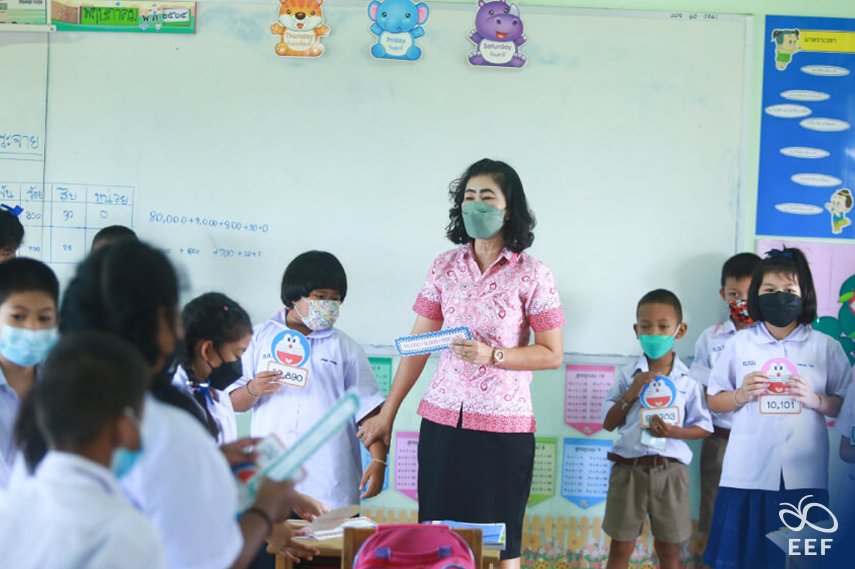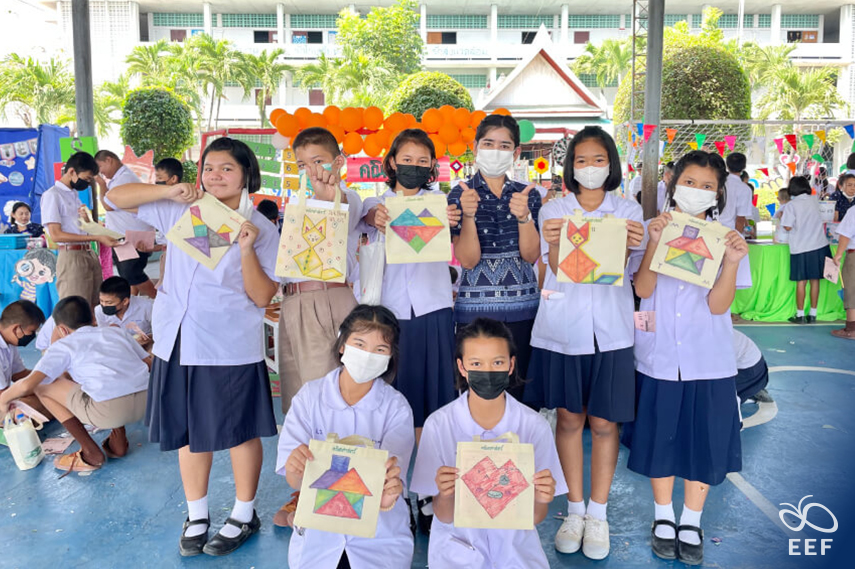
After facing severe educational disruption due to COVID-19, Samut Sakhon became a focal point of the nationwide “Post-COVID-19 Learning Discovery” initiative due to its industrial-heavy landscape, which left it among the last to reopen and resulted in a protracted educational blackout. To revitalize learning and student engagement, advancing educational recovery and innovation, the Equitable Education Fund (EEF) Thailand, Starfish Education Foundation, and UNICEF embarked on this bold initiative. As part of the EEF’s overarching “Area-Based Education (ABE)” initiative, they provide crucial support and expertise in teaching methods and educational technologies, featuring online lessons on the Starfish Labz platform to empower teachers in addressing learning setbacks. To further bolster this initiative, the partners build vibrant learning networks within and beyond schools, collaborating with the Provincial Education Office, Educational Service Offices, and local administrative bodies in Samut Sakhon. This collaboration facilitates regular online “Professional Learning Community (PLC)” sessions, where strategies for overcoming educational regression are shared. Additionally, the partners have allocated funds to schools to acquire diverse learning resources tailored to their unique contexts. Consequently, emerging from these multifaceted efforts as a particularly valuable tool is the “Learning Box,” helping students recover and thrive academically — and this gave rise to the groundbreaking “Samut Sakhon Learning Box.”

The Learning Box is a comprehensive educational package featuring a diverse range of learning materials, worksheets, journals, and assessment forms. It empowers students, particularly those with limited access to technology — such as the internet, satellite signals, mobile phones, TVs, or computers — and those facing uncontrollable issues like frequent power outages, as well as young children not yet ready for continuous online learning. Designed for home use, it allows students to learn and develop skills effectively outside the classroom. Tailored to each educational level, the Learning Box ensures age-appropriate knowledge and skills, emphasizing integrated learning across subjects like mathematics, science, Thai language, and art. This approach fosters academic competence, learning abilities, and socio-emotional skills through active learning activities.
The outcomes from the “Samut Sakhon Learning Box” will undergo thorough evaluation to guide its expansion into other self-managed areas in Thailand within the Area-Based Education framework, in collaboration with the EEF. Moreover, UNICEF plans to extend this model to other regions and showcase it globally as an exemplary approach to reducing educational inequality and promoting learning recovery for all children.

The success of the “Samut Sakhon Learning Box” has led to the development of five key measures designed to combat learning losses. These measures provide a strategic framework for educational recovery, integrating both traditional and online learning methods. They offer comprehensive guidance for schools severely affected by COVID-19 in Samut Sakhon, enabling them to support students, teachers, and communities effectively. This structured approach ensures that every dimension of the educational ecosystem is addressed, reinforcing the overall strategy for recovery and advancement. Start with
Step 1: School Landscape Assessment — Schools conduct environmental assessments to gauge and understand learning losses, evaluating family circumstances and readiness for online learning by visiting homes and reviewing access to technology and other resources;
Step 2: Whole School Planning — Schools use data from the School Landscape Assessment to develop comprehensive plans involving all personnel, ensuring readiness and confidence. These plans encompass safety measures, resource management, budgeting, and timeline coordination, with contributions from administrators, teachers, communities, and parents;
Step 3: Professional Development Support for Teachers — Schools enhance teacher skills in blended learning, active learning, ICT, and support for children with special needs to bridge gaps in teaching effectiveness during the pandemic;
Step 4: Intervention and Support for Students — Schools are encouraged to innovate and diversify learning methods and support through various teaching activities. Collaboration with parents, volunteers, and teachers is essential for designing and evaluating new learning tools and strategies;
step 5: Monitoring and Intervention Redesign — Schools systematically track and evaluate the outcomes of these measures, involving parents and communities in monitoring student progress. Regular feedback sessions with teachers help schools refine and improve their educational strategies.

These five measures are instrumental in addressing the multifaceted challenges of educational recovery. By providing a structured framework, these measures ensure a comprehensive approach to combating learning losses, integrating both traditional and digital learning methods. They empower schools to systematically evaluate and enhance their strategies, thus enabling effective support for students, teachers, and communities. The emphasis on collaboration and continuous improvement fosters an adaptive and resilient educational environment, ultimately advancing academic recovery and innovation in the wake of disruption. In addition to addressing the immediate challenges posed by the pandemic, this initiative also paves the way for a more resilient and inclusive education system, setting a benchmark for educational innovation and equity.
Incorporating these measures into the EEF’s Area-Based Education initiative significantly enhances their impact, extending their benefits beyond Samut Sakhon to other regions in Thailand. By setting a benchmark for educational recovery, these measures contribute to the broader goal of equitable and inclusive education. They provide a replicable model for other areas, demonstrating a robust approach to overcoming educational inequalities and fostering resilience within the Thai educational system. This initiative positions Thailand for national and international recognition as a leading example of effective educational innovation and recovery.

The Area-Based Education (ABE) initiative represents a steadfast commitment to leveraging local resources and readiness to ensure every child and youth not only completes their compulsory education but also reaches their full potential. Collaborating with the Equitable Education Fund (EEF) Thailand, Starfish Education Foundation, and UNICEF, Samut Sakhon has pioneered the “Samut Sakhon Learning Box” model, which tackles learning loss and educational inequality head-on, through a focused and innovative approach. Central to this initiative, the Learning Box delivers a range of effective home-based learning solutions tailored to various educational levels. This model has given rise to five essential measures: detailed assessments, strategic planning, professional development, innovative student support, and systematic monitoring. Together, these measures form a robust and adaptable framework for educational recovery. By integrating the Learning Box and these measures, the “Samut Sakhon Learning Box” model not only addresses immediate educational challenges but also sets a new standard for equitable and innovative education, significantly advancing the goal of a resilient and inclusive educational system throughout Thailand.

